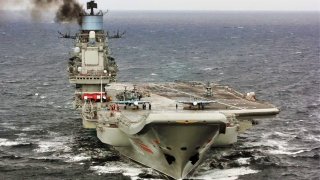Just Not That Into You: Why Russia Never Went Wild on Aircraft Carriers
During the Cold War, the Soviet Navy adopted a different approach to naval power projection compared to the U.S. Navy, which centered its strategy around aircraft carriers.
Summary and Top 4 Points: During the Cold War, the Soviet Navy adopted a different approach to naval power projection compared to the U.S. Navy, which centered its strategy around aircraft carriers.
-The Soviets focused on heavy cruisers, submarines, and the Moskva-class helicopter carriers, which were designed primarily for anti-submarine warfare rather than power projection.
-These helicopter carriers, while innovative, faced significant challenges, particularly with their engines, and ultimately failed to meet their potential, leading to their retirement by 1991.
-The struggles of the Soviet defense industry in maintaining and advancing military technology mirror some of the challenges faced by the U.S. defense industry today, underscoring the need for effective management and innovation in defense acquisition.
Soviet Moskva-Class Carriers: A Cold War Naval Experiment That Fell Short
The Soviet Navy had very different methods and capabilities for projecting power than did their great nemesis, the United States Navy, throughout the Cold War. Whereas the Americans developed a truly robust methodology for power projection, with the aircraft carrier as the centerpiece of those offensive capabilities, the Soviets did not even bother to counter the Americans in the domain of carrier operations.
The Soviets favored the heavy cruiser and other, smaller forms of surface warships. They also relied heavily upon their submarine fleet to continue projecting power in the face of the apparently overwhelming American carrier capabilities.
A Helicopter Carrier to Protect Subs
One interesting divergence from this, though, was the Moskva-class helicopter carrier. It was the equivalent of the Soviets dipping their toes in the vast ocean of complex maritime operations. Much smaller than aircraft carriers, the Soviets did contemplate using the Moskva-class helicopter carrier from which to deploy fixed-wing aircraft.
We see this dual-use capability in play even today, with far more advanced warships, such as Japan’s helicopter carrier, the Izumo-class destroyer which can readily deploy a contingent of VTOL-capable F-35 Lightning II warplanes from her deck.
In the case of the old Soviet Moskva-class helicopter carrier, it was initially designed only to deploy helicopters. The warships were designed not to project power as US flat tops are meant to do. Instead, they were geared primarily toward anti-submarine warfare. Back in those days, the concern were NATO’s Polaris-class subs. Interestingly, the Soviet concept for their light carriers was the exact opposite of how the Americans viewed their carriers.
For the Americans, their flat tops were the center of the US Navy’s operations.
Other warships were designed to operate in a defensive flotilla around the carrier known as the carrier battle group. The Russian version of the aircraft carrier, however, was meant to defend Russian submarines which Moscow believed was far more important.
Onboard these warships was the anti-submarine SUW-N-1 launcher that was capable of launching a 450 mm torpedo—or even a five kiloton nuclear warhead. She also carried upwards 48 surface-to-air missiles. There were also two 57 mm/80 mm guns.
Of course, the Moskva was not without its problems.
Engine Trouble for Aircraft Carrier
The biggest complication for the Moskva was the engines. The Soviets, as was the case with so many systems they crafted, cut corners. The ship designers initially wanted gas turbine-powered engines, but it was determined that steam-powered engines would be better.
Unfortunately, the steam-powered engines had to be rebuilt. The Soviets had great difficulty maintaining these ships. What’s more, the Moskva-class was dangerously slow.
Three of these warships were laid down, with the first two going to serve in the Black Sea Fleet based in Sevastopol. The third was canceled. The entire class was retired by 1991, because they had never lived up to their potential.
US Defense Industry Broken Like the Soviet Industry Was Broken
The Soviet defense industry had chronically been unable to meet increased demands placed upon it to better compete with the West. The designers knew the threat posed to them. Yet, the Soviet defense industrial base, particularly by the second half of the Cold War, could not meet the increased demands placed upon it.
Today, the US Defense Department’s industrial base is strained. Many programs that the Defense Department initiates are unable to be completed. And, when they are completed, very often these programs run over budget and under-deliver. The US Department of Defense must take care to fundamentally reorganize the way that it acquires news weapons platforms in order to avoid falling into the Soviet trap of defense acquisition.
About the Author
Brandon J. Weichert, a National Interest national security analyst, is a former Congressional staffer and geopolitical analyst who is a contributor at The Washington Times, as well as at American Greatness and the Asia Times. He is the author of Winning Space: How America Remains a Superpower (Republic Book Publishers), Biohacked: China’s Race to Control Life, and The Shadow War: Iran’s Quest for Supremacy. Weichert can be followed via Twitter @WeTheBrandon.


